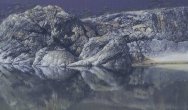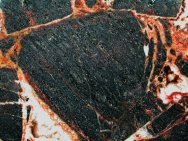Stromatolites Banded Iron Deposit
Geological Time: Archaean (2.73 Billion Years Old)
Size: 283 mm by 135 mm
Fossil Site: Jackson County Iron Mine, Jackson County Iron Formation, Wisconsin
This banded iron (basically iron ore) is testament to a process that began in the Archaean Eon and continued unabated for more than two billion years. During this vast stretch of deep geologic time, photosynthetic bacteria used sunlight and carbon dioxide in their metabolism and respired oxygen. Estimates vary as to when photosynthetic organisms first arose, roughly between two and four billion years ago at the extremes. Regardless, this oxygen produced by photosynthetic prokaryotes was first used up to rust the earth and seas. Prodigious oxygen was produced by vast stromatolitic reefs. Sometime probably in the Paleoproterozoic, sufficient iron was used up that rusting slowed sufficiently for atmospheric oxygen levels to build, ultimately reaching levels triggering a mass extinction of oxygen intolerant anaerobic prokaryotes (the so called Great Oxygenation Event) around 2300 million years ago. When eukaryotes appeared, and endosymbiosis occurred is also hotly debated (~ 1650 to 2700 million years ago). But when aerobic life did appear, that life benefited from the high energy obtained by burning oxygen, enabling evolution to march forward toward an explosion of diversity just before and after the base of the Cambrian, i.e., the Cambrian Explosion.
Images courtesy: John Adamek Also see: Precambrian Time Paleobiology |




